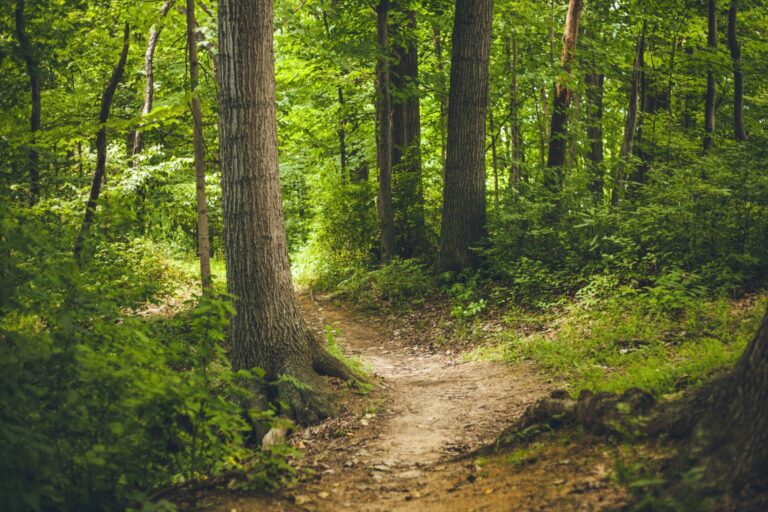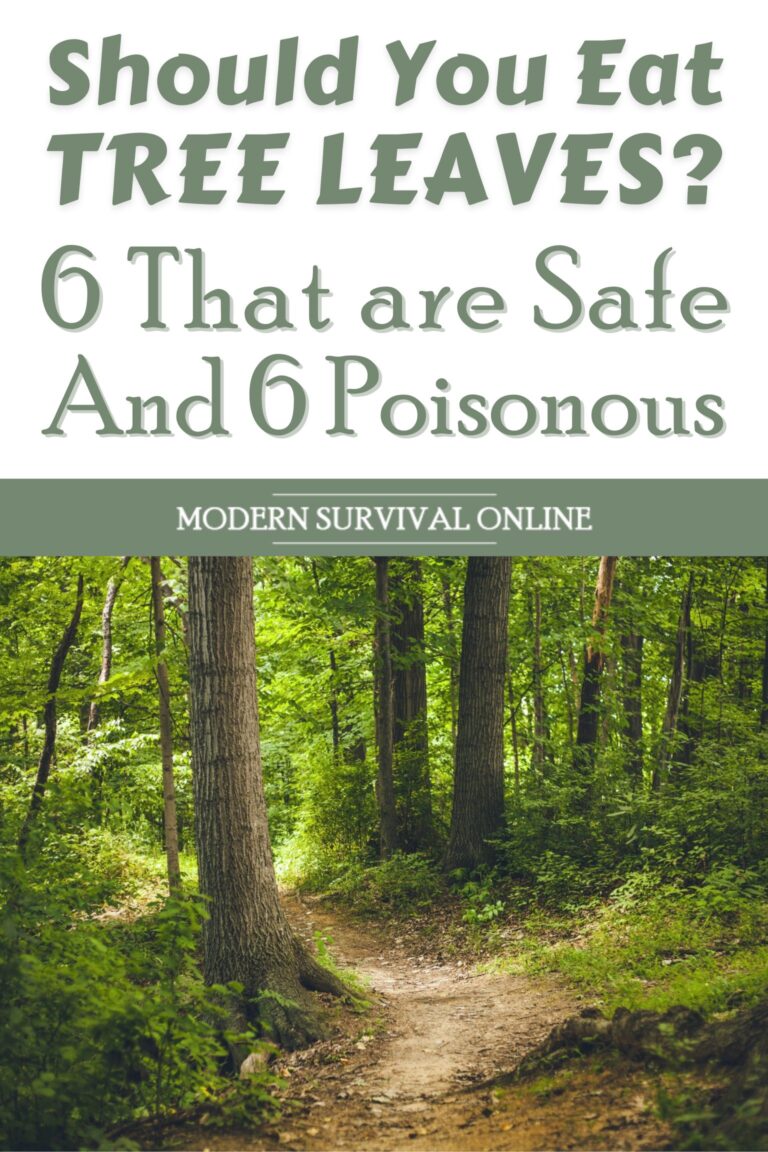One of the most fundamental challenges in a survival situation is getting enough food. Lots of wilderness lore and survival training revolves around identifying, collecting, and preparing wild edibles safely.

And though most of us think of hunting various critters, or picking safe berries and mushrooms, you might not have stopped to wonder if the leaves that grow plentifully on the trees all around you are safe to eat or not.
If they are, that could be a huge boon to your efforts! So, should you eat tree leaves?
You can eat tree leaves in a survival situation, but most offer very little in the way of nutrition. Though leaves can fill your stomach and offer some vitamins and minerals, many species are toxic and must be positively identified.
Leaves occupy a gray area when it comes to survival food. Many of them, especially ones from the most ideal species, are highly edible and even tasty, capable of filling your stomach.
But even among the best ones, they offer precious little in the way of nutrition, and many species of trees, including several look-alikes, are dangerously toxic.
As with all wild edibles you must learn your stuff before you partake of them, and even with expert knowledge you’ll need a backup plan when it comes to meeting your calorie and nutritional requirements.
Keep reading and I’ll tell you what you need to know…
Tree Leaves Have Always Been Eaten as “Famine” Foods
Throughout history, in times of scarcity or serious survival situations many people and cultures have turned to tree leaves as a source of emergency or supplemental sustenance.
Edible leaves provide an accessible and plentiful, if incomplete and marginal, food source when other options are unavailable for whatever reason.
Tree leaves can serve the same purpose today for survivors in need, or be gathered as an option for fulfilling gaps in your diet that you might encounter.
Tree Leaves Can be Useful Dietary Supplements
As mentioned, tree leaves don’t offer anything close to complete nutrition but they can serve admirably as useful dietary supplements.
Rich in essential minerals like magnesium, iron, and zinc, and in many cases having one or two vitamins, they can contribute to a balanced diet and help prevent the onset of horrible diseases like scurvy or rickets.
Pine needle tea is a well-known and traditional fireside offering that has long been used by trappers and explorers to provide vitamin C when fresh fruits were simply unavailable.
Additionally, many leaves can be brewed into tasty and soothing teas or used as garnishes for salads or other foods.
Either use can serve as a remedy or just flavor purposes, in both cases helping you thrive and keep your head in the game.
At Worst, Eating the Right Leaves Might Curb Your Hunger
Just because leaves are not a “high value” wild edible, that doesn’t mean they aren’t worth your time or effort.
Even though they don’t provide meaningful amounts of calories much of the time, consuming safe tree leaves can help curb hunger pangs.
This can be especially beneficial in survival situations where food is sparse and gnawing hunger is a distraction you can ill afford.
And, not for nothing, every calorie helps!
Warning: Many Trees are Highly Toxic, Even Deadly!
But, while some tree leaves can be an asset or even a lifesaver, others can be genuinely lethal.
It’s imperative to know which ones are safe to eat and which ones are not: Incorrect identification will lead to serious health issues, and even minor problems can turn deadly when you are already in a bad way.
When in doubt, err on the side of caution and avoid or look for trees that you can positively ID as safe.
The Following Common Trees are Safe to Eat
The following species are some of the most common trees around, and all have leaves that are safe to eat.
The rule of thumb is that you should always try to find the newest, greenest, tenderest leaves for consumption; older, mature or dead leaves are tougher to digest and have less nutrients to offer.
1. Birch
Birch trees are commonly found across the Northern Hemisphere, including parts of North America, Europe, and Asia.
Easily spotted thanks to their distinctive white bark, birch leaves are slightly sweet or else have a bracing minty flavor, and can be boiled or consumed raw. Great as tea or in a salad!
2. Beech
Beech trees predominantly grow in temperate regions throughout North America, Europe, and Asia. The leaves are typically light green, with new growth being a vivid green color.
All have a slightly bitter taste when eaten raw (usually a bad sign, but okay in this case). However, when cooked slowly over low heat they take on a milder, more palatable flavor.
3. Sugar Maple
The Sugar Maple is native to the hardwood forests of eastern Canada and the northern parts of the United States.
Most famous (and loved) for their sap which produces delectable maple syrup, their leaves are edible also.
They’re best when young and tender, with a flavor that’s mildly sweet and nutty. One of the best edible leaves around.
4. Sassafras
Sassafras trees are mainly found in the eastern parts of North America. The leaves have a unique, aromatic flavor that’s often described as a mix between woody, citrusy and root beer-like.
Traditionally, sassafras leaves have been used in all sorts of drinks and other recipes. Good for making tea, and a good option for eating if you can stomach the taste.
5. Mulberry
Mulberry trees are widely distributed across warmer regions of the globe. The leaves are quite bland in taste or mildly tart, but can be eaten safely raw or cooked.
They’re commonly used in teas or as supplement ingredients due to their high nutrient content.
6. Chinese Elm
The Chinese Elm, also known as the Lacebark Elm, is native to East Asia and many parts of the Pacific Rim. The small, dark green leaves a mild leafy flavor not unlike lettuce.
They can be eaten raw or cooked, and are commonly used in various cuisines in salads or as garnishes.
These Trees are Poisonous and Must be Avoided
Unlike the trees above, eating the leaves, or any other parts, of these trees can kill you. Some of them are lethally toxic. Learn them, and avoid them!
1. Yew
Yews are evergreen trees native to various regions of the Northern Hemisphere, and found in many subspecies around the globe.
They contain a toxic compound called taxine, which can cause dizziness, dry mouth, nausea, or worse if ingested. All parts of the tree are poisonous. Yews can be deadly for both humans and animals.
2. Cherry
Cherry trees are known for their beautiful blossoms, enticing fragrance, and delicious fruit. Many species are found worldwide.
However, unlike those wonderful fruits their leaves, stems, bark, and seeds all contain cyanogenic glycosides that turn into deadly hydrogen cyanide when ingested.
Bad news! Eating large amounts of the leaves, especially if they’re wilted or crushed, can lead to symptoms like difficulty breathing, increased heart rate, and fatal seizures.
3. Horse Chestnut
The Horse Chestnut tree, native to parts of Southeast Europe but found throughout much of Europe and the Northern US, contains a toxin called aesculin.
This toxic compound is found in all parts of the tree, but is particularly concentrated in the seeds and is highly toxic.
Ingesting even a small amount can cause nausea, abdominal pain, and severe vomiting, while larger doses can be lethal.
4. Manchineel
The stuff of literal nightmares. Considered one of the most dangerous trees in all the world, the borderline demonic Manchineel is found across Florida, the Caribbean, and Central and South America. All parts of this tree contain strong toxins.
Its sap causes skin blisters, and even coming into contact with rainwater that has touched it will cause blistering and hives.
Eating its small, enticing, apple-like fruit will cause burning pain, major digestive problems, and potentially fatal complications.
Any contact with the eyes can lead to temporary or permanent blindness. ID and avoid at all costs!
5. Black Locust
Black Locust trees, most common in southeastern United States, contain the toxin robitin, a type of lectin.
The bark, leaves, and especially the seeds can cause symptoms like nausea, vomiting, and abdominal cramps if ingested. Death is rare, but possible in cases of severe poisoning.
6. Rhododendrons
Rhododendrons are widely distributed across Asia, North America, and Europe. All contain grayanotoxins, present in their leaves, nectar, and pollen.
Consumption will result in symptoms such as vomiting, diarrhea, drooling, and heart arrhythmia. In extreme cases, it can potentially prove fatal.
You Must Take the Time to Learn What Trees are Safe in Your Region
To further complicate your search for edible leaves, some edible trees have dangerous lookalikes you’ll need to rule out.
For instance, consider the sugar maple tree above. Known for its sweet sap and leaves, it has a potentially harmful lookalike called the Norway maple.
While not outright deadly, the sap of the Norway maple contains toxins that will cause mild skin irritation or seriously upset your stomach.
Misidentifying these two could mean the difference between a welcome edible and bad reaction.
Similarly, lurch trees can sometimes be confused with cherry trees. There are many other examples besides for all kinds of other species.
Accordingly, a thorough, intimate knowledge of what trees are safe and edible and what trees are to be avoided in your area is paramount if you want to depend on them in a survival situation.


Like what you read?
Then you're gonna love my free PDF, 20 common survival items, 20 uncommon survival uses for each. That's 400 total uses for these dirt-cheap little items!
We will not spam you.